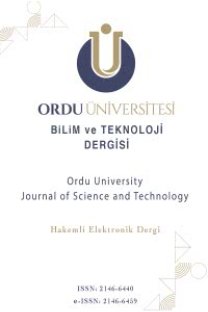Akdeniz'de İki Farklı Solea solea Popülasyonunda Otolit Kütle Asimetrisinin Karşılaştırılması
Otolith, Kütle asimetrisi, Solea solea, Ekolojik faktörler, Su kirliliği
Comparison of Otolith Mass Asymmetry in Two Different Solea solea Populations in Mediterranean Sea
Otolith, Mass asymmetry, Solea solea, Ecological factors, Water pollution,
___
- 1. Arai T, Ohji M & Hirata T (2007). Trace metal deposition in teleost fish otolith as an environmental indicator. Water, Air, & Soil Pollution 179(1–4): 255-263.
- 2. Bingel F (1987). Quantitative fisheries on eastern Mediterranean. Middle East Technical University, Institute of Marine Sciences, Erdemli, Mersin, Turkey.
- 3. Bostanci D, Yedier S, Kontaş S, Kurucu G, Polat N 2017. Comparison of the Otolith Mass Asymmetry in Solea solea and Trachurus mediterraneus. International Ecology Symposium 2017, 11-13 May, Kayseri, Turkey.
- 4. Campana SE (1999). Chemistry and composition of fish otoliths: pathways, mechanisms and applications. Marine Ecology Progress Series 188: 263-297.
- 5. Campana SE & Thorrold SR (2001). Otoliths, increments, and elements: keys to a comprehensive understanding of fish populations? Canadian Journal of Fisheries and Aquatic Sciences 58(1): 30-38.
- 6. Campana SE (2004). Photographic Atlas of Fish Otoliths of the Northwest Atlantic Ocean. Ottawa, Ontario: NRC Research Press.
- 7. Froese R & Pauly D (Eds) (2017). Species list: Solea genus Fishbas website. Available at: http://www.fishbase.org/identification/SpeciesList.php?genus=Solea (accessed on 07 December 2017).
- 8. Gronkjaer P & Sand MK (2003). Fluctuating asymmetry and nutritional condition of Baltic cod (Gadus morhua) larvae. Marine Biology 143(1):191-197.
- 9. Gündoğdu S & Çevik C (2017). Micro- and mesoplastics in Northeast Levantine coast of Turkey: the preliminary results from surface samples. Marine Pollution Bulletin. 118(1–2): 341-347.
- 10. Helling K, Scherer H, Hausmann S & Clarke AH (2005). Otolith mass asymmetries in the utricle and saccule of flatfish. Vestibular Research 15(2): 59-64.
- 11. Jawad LA, Al-Mamry JM, Al-Mamari HM, Al-Yarubi MM, Al-Busaidi HK & Al-Mamary DS (2011). Otolith mass asymmetry in Rhynchorhamphus georgi (Valenciennes, 1846) (Family: Hemiramphidae) collected from the Sea of Oman. Journal of the Black Sea / Mediterranean Environment 17(1): 47-55.
- 12. Jawad LA, Al-Mamry JM, Al-Mamari D & Al-Hasani L (2012). Study on the otolith mass asymmetry in Lutjanus bengalensis (Family: Lutjanidae) collected from Muscat City on the Sea of Oman. Journal of FisheriesSciences 6(1): 74-79.
- 13. Jawad LA, Mehanna SF, El-Regal MAA & Ahmed YA (2012). Otolith Mass Asymmetry in Two Parrotfish Species, Chlorurus sordidus (Forsskål, 1775) and Hipposcarus harid (Forsskål, 1775) from Hurghada, Red Sea Coast of Egypt. International Journal of Marine Science 7(21): 200-204.
- 14. Jawad LA (2013). Otolith Mass Asymmetry in Carangoides caerulepinnatus (Rüppell, 1830 (Family: Carangidae) Collected from the Sea of Oman. Croatian Journal of Fisheries 71(1): 37-41.
- 15. Jawad LA & Sadighzadeh Z (2013). Otolith mass asymmetry in the mugilid fish, Liza klunzingeri (Day, 1888) collected from Persian Gulf near Bandar Abbas. Anales de Biología 35: 105-107.
- 16. Lychakov DV, Boyadzhieva-Mikhailova A, Christov I, Pashchinin AN, Evdokimov II & Matkov AA (1988). Changes in the otolith apparatus of rat and fish after prolonged exposure to acceleration. Kosmicheskaya biologiya I Aviakosmicheskaya Meditsina 22: 27-33.
- 17. Lychakov DV (1992). Morphometric studies of fish otoliths in relation to vestibular function. Zhurnal Evoliutsionnoi Biokhimii I Fiziologii 28: 531-539.
- 18. Lychakov DV & Rebane YT (2004). Otolith mass asymmetry in 18 species of fish and pigeon. Journal of Gravitational Physiology 11(3): 17-34.
- 19. Lychakov DV & Rebane YT (2005). Fish otolith mass asymmetry: morphometry and influence on acoustic functionality. Hearing Research 201(1-2): 55-69.
- 20. Lychakov DV, Rebane YT, Lombate A, Fuiman LA & Takabayashi T (2006). Fish Otolith asymmetry: morphometry and modelling. Hearing Research 219(1-2): 1-11.
- 21. Lychakov DV, Rebane YT, Lombate A, Demestre M & Fuiman L (2008). Saccular otolith mass asymmetry in adult flatfishes. Journal of Fish Biology 72(10): 2579-2594.
- 22. Lychakov DV (2013). Behavioural lateralization and otolith asymmetry. Journal of Evolutionary Biochemistry Physiology 49(4): 441-456.
- 23. Mille T, Mahe K, Villanueva MC, De Pontual H & Ernande B (2015). Sagittal otolith morphogenesis asymmetry in marine fishes. Journal of Fish Biology 87(3): 646-663.
- 24. Nolf D (1985). Otolith piscium. In: Schultze HP (Eds), Handbook of Paleoichthyology, Vol. 10, Sttutgart: Gustav Fisher Verlag, pp. 1-145.
- 25. Özyurt CE, Kiyağa VB & Akamca E (2008). İskenderun Körfezi'nde Fanyalı Uzatma Ağları ile Dil Balığı Avcılığı. Ege Uninersity Journal of Fisheries & Aquatic Sciences 25(3): 233-237.
- 26. Popper A N & Lu Z (2000). Structure-function relationships in fish otolith organs. Fisheries Research 46(1-3): 15-25.
- 27. Takabayashi A & Ohmura-Iwasaki T (2003). Functional asymmetry estimated by measurements of otolith in fish. Biological Sciences in Space 17(4): 293-297.
- 28. Turgut E & Özgül G (2009). Sucul Ekosistemin İzlenmesinde Kirlilik Biyoindikatörü Olarak Balık Parazitlerinin Kullanılması. Gaziosmanpaşa Üniversitesi Ziraat Fakültesi Dergisi 26(1): 13-18. 29. Valentine DW, Soule ME & Samollow P (1973). Asymmetry in fishes: a possible statistical indicator of environmental stress. Fishery Bulletin 71(2): 357-370.
- ISSN: 2146-6440
- Yayın Aralığı: Yılda 2 Sayı
- Başlangıç: 2011
- Yayıncı: ORDU ÜNİVERSİTESİ
Tersinir Bir Altbloğa Sahip Blok Parçalanmiş Matrislerin Grup İnversleri İçin Bazı İfadeler
Derya BOSTANCI, Dilek TÜRKER, Serdar YEDİER, Seda KONTAŞ, Gülşah KURUCU
CoCrMo Tibial Komponentin Karbür Takım ile İşlenmesinde Yüzey Özelliklerinin Araştırılması
Erkan BAHÇE, Mehmet Sami GÜLER, Ender EMİR, Cihan ÖZEL
Tuğba ÖZBUCAK, Ömer ERTÜRK, Öznur ERGEN AKÇİN, Gülaycan POLAT, Selahattin ÖZBUCAK
Fındık Zuruf Kompostunun Yeşil Alan Tesisinde Örtü Materyali Olarak Kullanımı
Damla BENDER ÖZENÇ, Merve ŞAHİN
İletken Poli (Vinilferrosen) Filmi İçerisinde Prusya Mavisinin Elektrokimyasal Sentezi
Nesrin COŞKUN KURT, Mutlu SÖNMEZ ÇELEBİ
Akdeniz'de İki Farklı Solea solea Popülasyonunda Otolit Kütle Asimetrisinin Karşılaştırılması
Serdar YEDİER, Derya BOSTANCI, Seda KONTAŞ, Gülşah KURUCU, Nazmi POLAT
